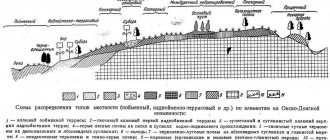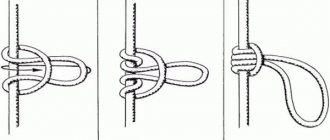Self-tightening knot - what is it?
Most types of knots and methods of tying them came to the modern world from the navy, although in this area it is used infrequently due to its unreliability. The fact is that a self-tightening knot holds tightly only under constant load; at the moment of weakening, it is quite capable of coming undone. Despite this, there are areas for its application.
This is the simplest original knot and in general represents one of the simplest types of noose. This unit reliably withstands heavy weight and traction, proportional to the strength of the cable or other material from which it is made. But you need to be careful when using it, making sure that the load on the node does not weaken.
For better reliability, there are several variations of this unit.
Varieties
To increase the reliability of the circuit described above, you can perform a few more simple manipulations. After tightening the knot, the free end is re-thrown around the support, brought behind the main rope and passed into the newly formed loop. This type of knot is called “with a half bayonet”. You can make one, two or more reinsurances if the length of the rope allows. Such self-tightening units will be more perfect; they will remain on the support even with a variable load.
In order not to be at all afraid of accidentally untying them, you can use a “constrictor”. This is translated from Latin as “boa constrictor”. And these reptiles are known to form very strong rings when holding a victim. The constrictor often cannot be untied at all and the rope has to be cut. However, if you do not use excessive force, the knot will do a good job of tightening the neck of the bag and securing the clothesline. In case of emergency, it is best suited to clamp a damaged artery or vein in the event of bleeding.
Tying a knot
The methods of tying this knot are among the simplest and fastest. All you need to create it is a rope with a running end and a support. Fishermen use a spool for this purpose.
The end of the rope is wrapped around the support, thus forming an open loop. At the end of the rope or fishing line you need to form a loop. First make a winding around it behind the running end and create a closed loop. The running end of the loop needs to be made several turns and brought out through the main loop. Pull it, the knot will tighten and, when loaded, show all its power.
To improve the strength of the knot itself when knitting, a self-tightening knot with half bayonets is used. It is performed no more difficult than the standard one. After performing the basic knitting technique, two half-bayonets are formed on the weight side. This type achieves maximum effect when certain conditions are met:
- if it is formed off-center;
- if the running end should be directed towards the intended load.
Similar nodes
| One of the closest is python node. In terms of their principle and application, they are practically equivalent. | |
| Whitened. | |
| Retractable bayonet. | |
| Picket knot. | |
| Gaff knot | |
| Miner's, although not purely marine, can also be used at sea. |
In general, the line of self-tightening marine fastening units is quite significant. Some work only under load, others remain strong even after applying force.
You can check out the 12 most useful sea knots here.
Where is it used?
He will find his place in all spheres of life. It is often used in mountaineering and in warehouses (they are used for hanging heavy objects). Fishermen use it when tying gear for fishing from the shore.
Shock-absorbing units are popular. They are formed on an additional rope, which is used to connect a spare fastening in case of destruction of the main one. There are also self-tightening units for transporting goods or for various rescue operations. These include the braking unit, “belts” and mariner.
There are two types of fastenings - simple and complex, for different life situations. In the navy, the original self-tightening knot is rarely used, with preference given to its variations.
Fastening
The mount is often popular with fishermen. Although experienced fishermen suggested tying a self-tightening knot for fishing line without additional parts, their use makes life much easier. The fastening helps to fix the loops during knitting, prevents the knot from unraveling abruptly, and simplifies the knitting process. On the shelves of fish stores you can now see reels with a stopper for attaching braid. Many anglers reel in the line held by the spool without unnecessary fasteners, but only those who have gained experience over many years.
Application
Self-tightening knots are used not only by climbers and sailors. Some sources claim that there are about twenty such schemes. Knowing them all is not necessary even for a professional. But some universal combinations can be useful to the common man.
When relaxing outdoors, the “constrictor” knot will securely secure the hammock, and the “gazebo” will help to equip a canopy from the rain. For housewives, there is a “burlak sea loop” if there is a need to tighten a clothesline from sagging or organize drying for collected medicinal herbs. When walking your dog, sometimes it becomes necessary to leave your pet securely tied to a support for a while. A simple cow knot will do the trick. It knits easily and quickly allows you to release the leash.
This is interesting: Beaver hunting dates
Self-tightening fishing line knots are a must have in any fisherman's arsenal. They are also useful for securely fastening the boat. For those going on a mountain hike, knowledge of the components for belay equipment is simply necessary.
Kinds
There are 18 types of self-tightening knots in total, but using one rope there are only 4 types:
● Classic Prusik.
● Cross.
● With an “arb” carbine.
● Bachmann knot (with carabiner).
The number of turns is unstable; if necessary, it can be increased.
It is necessary to highlight one of the strongest knots - the constrictor knot. It gets its name from the zoological name for the boa constrictor, Boa constrictor, which defeats its prey by strangulation. This self-tightening rope knot is reliable and is made using rounded objects instead of support. As soon as the support disappears, it dissolves itself.
Types of self-tightening loops
There are a considerable number of different self-tightening knots, but we will consider the most popular and used in various fields:
- Knotted design with half bayonet. It is similar to a classic knot, but the free end is again passed inside the support, brought behind the main rope and pulled into the resulting loop. If the length of the rope allows, then you can make more harnesses;
- Cow type knot joint. This type of unit is actively used in the navy, however, it can be used on land. This type of knot should be tied in the shape of an inverted bayonet;
- A blind loop does not depend on a constant load; in order for it to hold tightly, you just need to tie it and tighten it well. The knitting of a knotted structure occurs in such a way that one loop is inserted into the other and tightened;
- The constrictor is the strongest of the presented options, since after tightening it does not come undone. Usually it is cut to free one or another object. It is most applicable in everyday life; it can be used to tie a variety of hoses, bags, and round objects.
This is interesting: Picture of a compass with symbols
A standard self-tightening loop is used on a cable that is attached to a crossbar for a variety of bags. This helps protect supplies from dampness and rodents. It can also become easily untied. You need to insert the running end of the folded loop into the loop; in this case, if necessary, you can quickly untie it by simply pulling the end of the nodal structure.
Use of the knot by anglers
A self-tightening knot for the top of the head is actively used by fishermen. It is a structure made from a block of tops with a weight. Tying such a tackle is quite simple.
To do this you will need a fishing line, a double leader and a sinker. A special sinker must be purchased at the store, otherwise the entire device may fail. Most often it looks like a horseshoe with a hole in the center of the product. The top bar is tightened using a self-tightening knot and hung with hooks.
To decorate the tackle, take a fishing line 4 mm in diameter and up to 50 cm in length. The line is pushed through the hole into the sinker to the middle, after which it is brought up. Insulation is put on it and a loop is made. After this, a self-tightening knot is formed, onto which the crown is attached. The insulation serves as a fastener for a long leash on the side of the free end of the fishing line, on which a swivel is attached to protect the fishing line from twisting in the current. Having secured the cake block with hooks, you can consider the task completed. The workpiece is attached with a carabiner to the main fishing line. The bait is ready to be cast. Getting into the water, it gradually gets wet, and the crumbling cake from the top spreads in the reservoir, attracting the desired fish.
Nautical
Initially, a self-tightening rope knot was created by sailors to secure sails and various objects on deck. Reliable nodes are the key to success, because the seas and oceans are so turbulent. During the heyday of navigation, there were more than 500 types of knots. Tying sea knots is a whole science. But with the introduction of the steam engine, the need for sails disappeared, and knots began to be used less. And the change in the composition of the materials of cables and ropes caused some knots to lose their effectiveness.
A self-tightening knot was used in maritime affairs for fastening to cylindrical objects. It is simply called a noose, since the hanged noose was tied according to the same principle. In the event of no load or variable traction, the running end slides out, dissolving the entire assembly. This was the reason for refusing to use it. Therefore, the navy began to use a constrictor and self-tightening knot with half bayonets. The peculiarity of its knitting is that the knot itself is placed offset, so that the running end is directed towards the load. Due to this, it will not slip out so quickly.
Features of winding fishing line on a reel
Why is proper winding necessary?
Connecting the fishing line to the spool
The first step in equipping a reel with fishing line is securing the line to the spool. Many anglers do not secure the line, hoping that the lower layers will not be used, but this is not entirely the right approach. Over time, the top working layer will wear out and gradually shorten. There are many methods of tying, but the most common are a specially designed knot and a self-tightening loop:
- The special knot is very reminiscent of a clinch. Its advantage is that it practically does not stretch and holds perfectly.
- The self-tightening knot has a slight stretch, but under the influence of the tension of the fishing line it will continue to be tightened until it stops.
Backing (rewinding)
Taper profile
Different fishing reels apply wraps of line to the spool differently. There are three types of winding:
- Cylindrical.
- Trapezoidal.
- Chaotic.
In turn, trapezoidal winding has two types of taper: direct and reverse.
A straight cone is formed if the technical feature of the reel provides for laying the turns with a decreasing pitch towards the spool wall. This cone ensures minimal friction of the turns during release. With a reverse taper, the pitch gradually decreases towards the spool flange. The friction of the turns with such a cone is greater, but the likelihood of spontaneous dropping of the line is reduced.
- blood ties;
- grinner;
- Peter Minenko's node.
Advantages
The self-tightening knot has gained recognition primarily due to its ease of knitting and high efficiency. Despite its unreliability, it is often used, but only in those cases when they are sure of the presence of constant weighting. When forming the unit, no additional materials or devices are required. The main task, which it copes with brilliantly, is to withstand a load proportional to the density of the cable (rope, fishing line, cable) from which the knot is knitted.
If there is constant weight, the knot is not able to untie on its own, only manually, which will also not cause trouble. It is as easy to untie as it is to tie. This advantage was appreciated by fishermen and climbers, for whom every second is precious. This property makes this node a leader.
Even a child can learn how to knit a noose, and proper use contributes to the maximum realization of the expected result - reliable holding of a large weight.
Complication
Using a simple self-tightening knot as a basis, you can easily move on to the “noose” pattern. To do this, before tightening, the free end is twisted three times around the rope that forms a loop. When tightened evenly, the connection is securely fixed due to repeated pressing force against the support. Untying such a knot without loosening the main rope is problematic.
This is interesting: What are the methods of transporting a victim on water?
A self-tightening knot with a loop can be useful in everyday life for shortening a sagging clothesline. With its help, you can temporarily “hide” (make inactive) a section of the cord with damaged fibers, which theoretically can break under load. The advantage of the “burlatsk sea loop” knot is its ability to be tied on any part of a fixed rope that does not have free ends.









